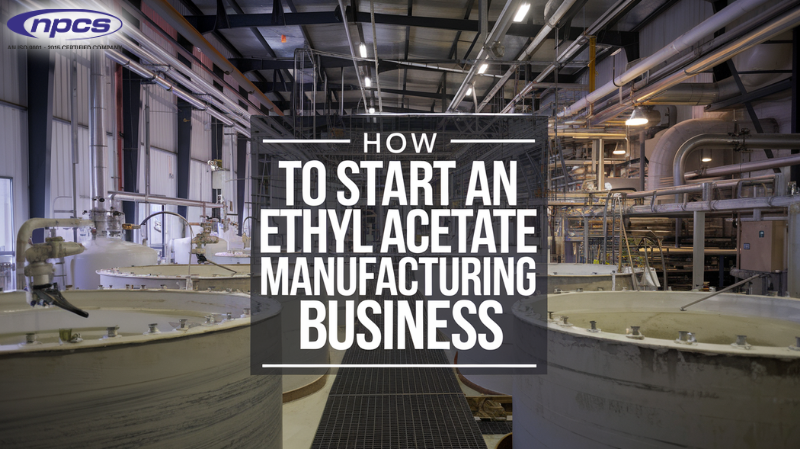Ethyl acetate, a helpful organic compound, finds wide use across several different pharmaceutical industrial applications, including coatings, adhesives, pharmaceuticals, and as a solvent. The compound’s versatility makes it a crucial ingredient in many products across several industries. Starting an ethyl acetate business is a tremendous opportunity for entrepreneurs. This will give a comprehensive look into starting a business in ethyl acetate manufacturing, the markets it can enter and the economics of an ethyl acetate venture. And to present essential equipment, skills and methodology, competitors, as well as a business strategy for success.
What is Ethyl Acetate?
Ethyl acetate is a clear colorless liquid with a sweet fruity smell. Manufacturers typically produce ethyl acetate through an esterification of ethanol and acetic acid. It has the chemical formula C4H8O2, and industries generally use it as a solvent in products, such as paints, coatings, inks, perfumes, and pharmaceuticals. Companies also use this compound in the decaffeination process of coffee and tea.
Join With Us
Why Start an Ethyl Acetate Manufacturing Business?
Investing in ethyl acetate production is a sound investment for several reasons:
- Strong Demand across Sectors: Ethyl acetate has many uses, from usage in resins as a solvent, coatings, adhesives, and synthetic flavors, which makes it an important chemical in many sectors.
- Growing Market: Resellers’ shift in focus and increased use of ethyl acetate in paint and coatings, pharmaceutical operations, and food processing will likely drive up the demand for ethyl acetate quickly.
- Value: With great production management and entering into the market, the business model can achieve a very elevated value due to the high cost of ethyl acetate.
- Easily Scaled: You can start the business with small-batch production, and once you achieve good market penetration, you can increase production to meet demand.
Benefits of Starting an Ethyl Acetate Business
Wide Market Application: Manufacturers, food processors, and pharmaceutical companies use ethyl acetate, which provides a steady and consistent demand for the product.
Export Value: Companies trade ethyl acetate openly around the world, which provides opportunities for international trade and commerce.
- Sustainability: Given the trend of industrialization and growth in end-use markets, the demand for ethyl acetate will correspondingly increase, allowing for sustainable demand and business model.
- Environmental Concerns: Ethyl acetate is one of the least toxic volatile organic compounds (VOCs, is biodegradable, and is environmentally favorable and friendly. These themes can go to market.
Detailed Exploration of Profitable Chemical Industry Business Ideas
Top Applications of Ethyl Acetate
- Solvent for Coatings and Adhesives: Ethyl acetate is an excellent solvent that offers relatively fast evaporation versus other solvents when it comes to end-products such as coatings and adhesives.
- Pharma: Ethyl acetate is a useful solvent in fundamentals of drug formulation, and solvent in the extraction medium.
- Food/Beverage: Ethyl acetate is a flavoring agent used in food, and is used as a pre-extraction solvent on decaffeinating coffee and tea.
- Ink for Printing: Ethyl acetate serves as a solvent in the manufacturing of printing inks to provide an appropriate consistency of the inks and stability of the inks.
Production Methods
The two-step process for production of ethyl acetate is as follows:
- Raw Materials: Ethanol and acetic acid are the primary raw materials used in production, and both should be high purity standards.
- Reaction: Ethyl acetate is produced through the esterification of ethanol with acetic acid in the presence of a catalyst- sulfuric acid. The reaction is achieved through heating the mixture in a controlled manner, at a certain temperature.
- Separation & Purification: Once a reaction is complete and mixture cooled, ethyl acetate is separated from last reactants: unreacted ethanol and unreacted acetic acid. Distillation methods are often used to achieve purity at the final product stage
- Drying & Storage: Manufacturers then dry ethyl acetate and store it in germ resistant containers to prevent contamination or degradation.
- Quality Control: Manufacturers complete quality control checks during the ethyl acetate processes to ensure quality during production and shipping conformity to industry standards.
Essential Machinery for Ethyl Acetate Manufacturing
After one has established an ethyl acetate manufacturing firm, the following equipment must be provides:
- Reaction Vessel: The esterification reaction of interest occurs in vessels constructed from resistant materials that can endure high temperatures.
- Distillation Columns: Manufacturers need Distillation Columns to complete separation. And purification of the produced ethyl acetate from the reaction differential partners.
- Heat Exchangers: Manufacturers need Heat Exchangers to control temperature during the esterification process.
- Storage Tanks: Tanks resistant to contaminants need to be provided to store raw materials and the final product being shipped.
- Safety Equipment: Fire suppression systems and personal protective equipment are necessary. Emergency showers are also a necessary element to provide a safe working environment
Related projects on: Chemicals (Organic, Inorganic, Industrial) Projects
Starting Your Ethyl Acetate Manufacturing Business
Conduct Market Research
Understand market dynamics, recognize who is going to buy, and how your competitors approach their market. All of this will help you recognize unmet needs that your business could service and identify opportunities to create a distinct offering in the marketplace.
Develop a Detailed Business Plan
Construct a business plan that is as detailed as you with regard to planning for production, marketing, financial forecasting, and operations. This will serve as a strategic guide for your business. As it grows to gain stakeholder support and attract prospective investors.
Ensure Regulatory Compliance
Production of ethyl acetate deals with hazardous materials and production will require thorough understanding. You are required to have theater or lawful licensing from any environmental and safety agency. Understanding regulations and safety practices related to handling hazardous materials are required to ensure workers and community safety.
Build a Manufacturing Framework
You should build your manufacturing facility, including all required equipment, and ensure you meet safety and environmental standards.
Procure Raw Inputs
Negotiate a safe and reliable supply of ethanol and acetic acid. Long-term contracts with suppliers will ensure an ongoing flow of inputs.
Quality Control
Build standards and quality assurance over each step of production to guide production of a product that meets industry standards.
Marketing and Sales Strategy
Develop a sound marketing strategy in industrial segments like coatings, adhesives or pharmaceuticals. Attend industry events and increase your online presence to blast products to potential customers.
Research and Development
Invest in research and development to create efficiencies via deployment and application related to production, market applications. It cost savings in supply, construction of packaging clearly defined by your organization in advance. Investing in R&D will help you stay competitive and leverage learning innovation.
Conclusion
Manufacturing ethyl acetate is becoming a profitable opportunity best suited for a start-up entity. Follow all the steps initially outlined here, and have a clear understanding of market demand, supply procurement, production. It regulatory compliance in order to serve and build a continued and profitable place in the chemical industry.






